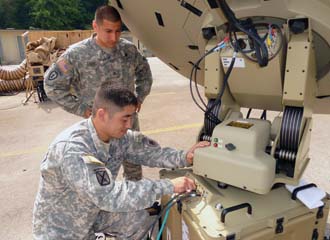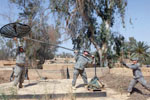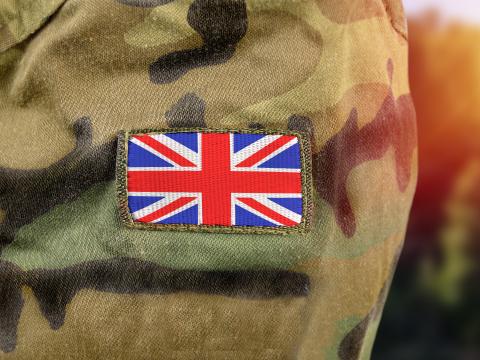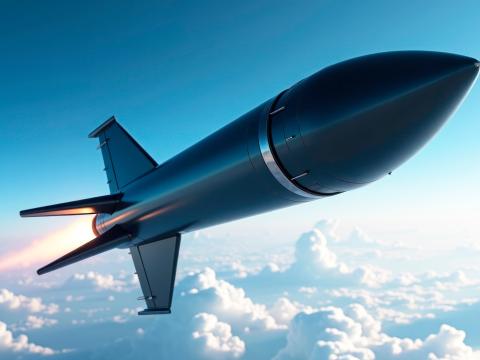Software Drives Future Army Communications
 |
U.S. Army soldiers adjust cables on a satellite communications dish. Army communications and information systems are becoming more sophisticated and reaching further down to the force. |
U.S. Army communications is more likely to be software-driven in the future as radios increasingly resemble specialized computers. Apps will be driving advances, and computer-like acquisition policies for radios will help speed cutting-edge technology to the field.
Technologies are pushing capabilities further down the line in the battlespace, and the personnel who support them are changing in number as well as in expertise. New commercial systems are driving not only warfighter capabilities but also the new acquisition policies that promise broad changes in both hardware and software systems.
Today’s battlespace information systems have left their support role far behind and now are a critical component of warfighting, declares Maj. Gen. Alan R. Lynn, USA, commanding general of the U.S. Army Signal Center of Excellence and Fort Gordon, and the chief of signal for the U.S. Army Signal Corps. Sophisticated capabilities in the communications arena are key enablers for the force, he emphasizes.
Army Signal 10 years from now likely will be defined more by software than by hardware. Hardware such as routers and intrusion prevention systems probably will go away, the general suggests, and many networks will software-based with substantial virtualization.
Today’s Signal Corps relies heavily on video, data and voice communications—in that order of use, Gen. Lynn offers. With voice now the lesser of the three, pushing those capabilities to the lowest echelons is the top priority, and this requires greater agility.
One of the key concepts under pursuit by the Signal Corps is known as microcyber. Gen. Lynn explains that this approach parallels the continuing miniaturization of electronics by reducing the size of signal communications teams. These teams are being restructured into smaller, more capable units that can be assigned deeper down into a warfighting organization.
The microcyber effort emerged from a periodic functional area assessment. This year’s assessment illustrated that the Army has more communications requirements than it could support, the general relates. With a mandate restricting force growth, the Signal Corps had to find a way to improve communications capability with fewer people. “The only rheostat you had was to change the equipment, because you couldn’t change the personnel number to provide that additional support down to the lowest level from battalion level,” Gen. Lynn explains.
So, the Signal Corps examined its equipment sets to determine which ones could be operated by smaller teams while featuring improved capability. Previously, nine people were required to operate line-of-sight/satellite systems. Now, a four-person team has the same capability as that nine-person team.
This smaller team can be pushed further down into the force to provide advanced communications to the lowest level, the general continues. The Signal Corps currently can support communications down to the company level, but ultimately that support is needed as far down as the squad level, he notes. The goal is to have microcyber systems fully in place by 2014.
With the Army turning to smaller units, the biggest thrust is to change programs of instruction so that they meet the equipment sets, Gen. Lynn says. The Army is combining military occupational specialties so that soldiers are not trained exclusively on a single technological capability such as satellite, line-of-sight or tropospheric scatter systems. Instead, soldiers would be trained as transmission experts who are familiar with the theory for each of those capabilities.
“The challenge is going to be to bring all of those in the field who currently are trained on just one device either back to the schoolhouse—not likely—or to train online where they will get the other certifications so that they can get the new MOSs [military occupational specialties],” the general states.
New handheld technologies are aiding that effort. For example, a satellite rig in the center’s training site has a quick response (QR) code attached to it. Students can scan the QR code into an iPad, and the training course—either written or video—will download into the handheld unit. A proctor monitors the students on their iPads both for individual assistance and for class trends that might require adjusting the curriculum. Gen. Lynn adds that soldiers really enjoy this type of training environment.
Some trainees bring individual expertise that actually adds to classroom training. While they are more comfortable with today’s new technologies than any other group that preceded them, the trainees are not uniformly adept. Much of their training is self-paced, and they can provide immediate feedback to instructors to improve training.
The Army’s communications technologies have evolved over the years to become more versatile. That can be both a blessing and a curse, as the new technologies bring a host of new complications with their advanced capabilities. Gen. Lynn cites as an example the iPhone, the use of which provides challenges in training.
With training, a device that performs a multitude of functions requires a shift from training to education. The focus is on theory rather than just on equipment operation.
The Signal Center is building apps in its school for training. Today’s soldiers are accustomed to working on apps, Gen. Lynn observes, and the Army apps are a better model from which these soldiers can learn. “We’ve developed some apps that look just like the devices themselves—with the buttons and the switches that act exactly like the systems on a handheld device like an iPad. They’re learning on those,” he relates.
This leads to the next item on the general’s wish list. He wants industry not only to build a training device on a portable unit such as an iPad or an iPhone, but also have that training element serve as the graphical user interface (GUI) to actually operate the system. This would solve many of his training challenges, Gen. Lynn offers.
Acquisition reform is another goal, and Army communicators are working to solve that problem. “The way acquisition is set up today, it is very difficult to get a newer piece of equipment to the field quicker,” the general declares. The ongoing Network Integration Evaluation (NIE) at Fort Bliss provides industry with an opportunity to offer its latest technologies to meet Army communications needs quickly. The NIE features program-of-record equipment that can be combined with these new technologies with the goal of filling gaps in Army requirements.
 |
A group of soldiers erects a line-of-sight communications antenna in Iraq. Future Signal Corps communications teams will consist of fewer personnel with improved capability. |
The Signal Corps is trying to drive some acquisition changes, Gen. Lynn continues. And, at the heart of that effort is the changing nature of Army communications hardware. He points out that, in today’s high-technology environment, many of the corps’ communications systems actually are specialized computers. Treating future systems as if they were computers can help the acquisition process.
“I think we broke the code on the acquisition of computers by the CHESS [Computer Hardware, Enterprise Software and Solutions] program; where we buy the latest and greatest computer that’s on the market each year, and then the whole Army goes after that buy so we get a higher quantity at a better price with all the maintenance and warranty pieces all tied into it,” the general says. “I think that’s a great model for what we need to do for future communications systems, because they’re all more and more software-driven systems. They’re just specialized computers, and we think that [CHESS] is a great model.”
CHESS began as a small computer acquisition effort designed to implement commercial information system solutions rapidly, but Gen. Lynn sees its utility on a broader scale. This way, if a new satellite modem came into existence just as a force was rotating into Southwest Asia, that modem could be placed on an approved products list so that units could buy it for immediate use in the field. Afterward, an all-out Army buy would equip future units as they deploy to the field, he explains.
And, this approach dovetails with the nature of radios evolving to resemble specialized computer systems. “We’re going to be driven to a lot more commercial off-the-shelf systems if we are going to be able to afford the numbers of communications equipment that we get,” the general posits. “So, modifying software is going to be a lot easier problem than modifying hardware; and the systems I’m seeing today are really software-driven radio systems.”
Applications will be driving most of the advances in Army communications, and that affects both acquisition and training. “The young people today are much more tech-savvy than many of the people who have come before them,” he observes. “They’re used to using a lot of different apps that work for them uniquely. As we go to the future, that will be the case even more—you will use the app that is best suited for you, as long as there is a common platform for it.”
The commercial sector will continue to play a role in this software development, and Gen. Lynn wants industry to develop models for software and how to make it work. This software-driven future will be app-rich, and these applications and their platforms should be as simple as possible.
The training GUI that the general wants would fit into this simple software model. A GUI that looks the same across different systems such as satellite, line-of-sight and tropospheric scatter communications would provide an intuitive tool for users.
The move to cloud computing that is pervasive in the military is not new to Army communicators, Gen. Lynn states. However, he does not believe that all of the Army’s battlespace data will reside in the cloud.
“I think it’s important to provide more capability on the data end—that we build structures that have cloud but that also have forward-caching capabilities; forward smaller clouds if you will,” the general offers. “I’ve had experience where I relied on a cloud-type computing forward in a war zone, and when I got disconnected I lost that capability, which is not a good model.
“You have to be really careful that you draw a line between what you need forward to have on hand in a war fight, and what you need to reach back into the cloud for,” he declares. The differentiator might be information that the soldier needs about his or her immediate environment versus background information to help accomplish a mission. Determining how the cloud can be used best may be the focus of future discussions about the cloud’s role, the general says.
The move to the cloud has brought renewed focus on cybersecurity, which long has been a bailiwick of the Signal Corps. The creation of the U.S. Cyber Command has not largely changed the corps’ mission, Gen. Lynn says. Network defense always has been a significant part of its mission—as much as 80 percent of its network activity, he allows. What has changed is the level of complexity, especially in terms of cyberattacks taking place. So, the Signal Center has created new cyber training for a few select groups.
A new MOS—255 Sierra—has been created for warrant officers who will be the information assurance/computer network defense (IA/CND) experts. These warrant officers have been trained to high standards in Army and other service schools, as well as in the SANS Institute, the general notes. Two classes have graduated, and Gen. Lynn reports that SANS Institute personnel were so impressed with their Army graduates that they wanted to use them as instructors.
The Signal Corps also is assessing having cyber noncommissioned officers at the staff sergeant level. These personnel also will have specific IA/CND skills at the brigade level, the general says.
Technology approaches also offer potential security solutions. Many problems with attack vectors could be solved with session-spaced systems that would morph during operations. This would make them less vulnerable to attack, the general offers.



Comments